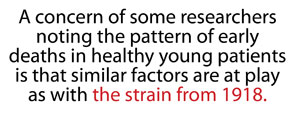Every emergency physician in practice for a few years can remember a patient who developed and died from an infection that would ordinarily not have that outcome. This often occurs from a final common pathway that includes failure to respond to usual anti-infective agents, progressive and unresponsive shock, Acute Respiratory Distress Syndrome (ARDS) and inability to oxygenate and ventilate effectively.

This pathway is one familiar to clinicians as the Systemic Inflammatory Response Syndrome (or SIRS), with the final outcome of septic shock and death. Independent of the etiology, SIRS has the same pathophysiologic properties, with minor differences in inciting cascades. SIRS has been described in a 3-stage process, ending with the activation of the reticular endothelial system and subsequent loss of circulatory integrity. This leads to multiple organ dysfunction syndrome. Ultimately, the combination of poor oxygenation and poor perfusion result in cardiac arrest and death. It has been common to associate this sequence with gram-negative organisms, but it appears the H1N1 pathology may be characterized as a “viral-induced SIRS”.
One of the evolving mechanisms for SIRS, and one which relates to many other rapidly fatal diseases, is the notion of a “cytokine storm.” This theory has been in existence for many years, discovered through research into the pathology of the flu outbreak of 1918, and diagrammed in complete form by Dr Osterholm in 2005. Beyond gram-negative bacterial endotoxins, this mechanism has been proposed by which infective agents can cause vascular collapse and irreversible shock. The term “cytokine storm” refers to the sudden and massive release of these substances (cytokines) related to infections by all types of organisms, including viruses.
Cytokines are polypeptides secreted by immune and other cells when the cell interacts with a specific antigen, endotoxin, or other cytokines. The major mechanism of cytokine production is through lymphocyte interaction with a specific antigen trigger. But cytokines themselves may not be antigen-specific, so they precipitate reactions to due to infectious, inflammatory and immune (i.e. cancer) stimuli. Cytokines include at least 30 identified interleukins, at least 3 identified interferons, at least 2 types of tumor necrosis factors, more then 4 colony-stimulating factors and several transforming growth factors.
The fierce and convoluted interplay of these cytokines has generated the image of a complicated weather event, thereby the term “Cytokine storm”. The “Cytokine storm” may result in an exaggerated immune response, with rapidly proliferating and highly activated T-cells and natural killer (NK) cells. These cells release further substances, which can damage infected and normal tissue. The result of the cytokine release affects the lungs, damaging alveoli and the lung parenchyma . A final pathway is the Acute Respiratory Distress Syndrome (ARDS).
The lethality of this process has been noted in more severe flu viral infections, especially in fatalities and hospitalized patients. The H1N1 strain of influenza virus that caused the Pandemic of 1918, was noted to cause a severe form of respiratory compromise. More than half the deaths occurred among largely healthy people between 18 and 40 years of age. The ARDS-related morbidity and mortality in the pandemic of 1918 was on a much larger scale than those of the influenza outbreaks of 1957 and 1968. So, study of the outbreaks and pathology causing deaths in 1918 and in 2009 may lead to a more clear outline of infection-related deaths, and the roles of cytokines and other mediators. A concern of some researchers noting the pattern of early deaths in healthy young patients is that similar factors are at play as with the strain from 1918. Clinical, epidemiologic and laboratory evidence suggests that a pandemic caused by the current strains may mimic the 1918 pandemic more than those that occurred in the mid-century.
Already, deaths in young patients have exceeded 100, and the nation’s children’s hospitals are busy. The vaccine has reached the point of public administration, and health care workers, children and pregnant women are the primary initial target populations. Each of these groups are generally composed of immunocompetent persons. Thus, such targeting is very different than targeting for the usual seasonal flu. Hopefully, the vaccination process will reduce the infectivity and induce some “herd immunity”. Study of infected persons will no doubt produce a greater understanding of the active immunologic factors differentiating fatal and non-fatal cases, and the impact cytokines and other humoral factors will have on an influenza death toll, which none of us have experienced in our lifetimes.
Here’s hoping the study population is a small one.
Reference:
Preparing for the Next Pandemic Osterholm, MT. New England Journal of Medicine, 352 (18): 1839-42. May 5, 2005
Jim Augustine, MD, is the Director of Clinical Operations for Emergency Medicine Physicians (EMP)




1 Comment
In 2002, we published the unexpected finding that autoimmune diseases as well as some infectious diseases–viral hepatitis, HIV, TB–were associated with overactivity of angiotensin I-converting enzyme (the ACE deletion/deletion, or D/D, genotype). ACE (CD143) appears on the macrophage membrane early during activation. Could angiotensin II be an early signal in the pathway that eventually becomes “cytokine storm,” the drizzle before the hurricane?
So far, the evidence appears to be supportive. In 2004, we published our first 8 patients with West Nile virus encephalitis. Using an ARB reversed coma in 12-24 hrs, instead of the usual 48-72 hrs. Overall, we’ve had 70% treatment response in the 30 patients we’ve used an ARB in since 2003, about the same in the 10 horses with WNV, and less (50%) in the 12 birds. Birds w/ WNV present sicker.
Anyone interested in trying an ARB for swine flu, or any other flu, for that matter, is welcome to download the trial documents at our home page, http://www.genomed.com by clicking on “Flu Trial.” ARBs could well be general viral antidotes; we’ll just have to see.